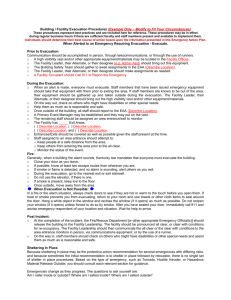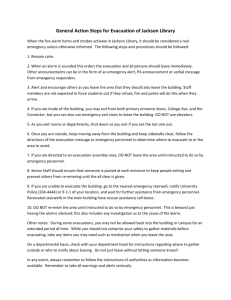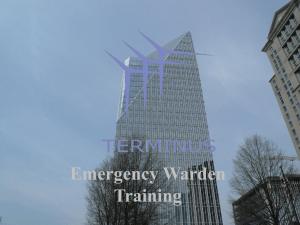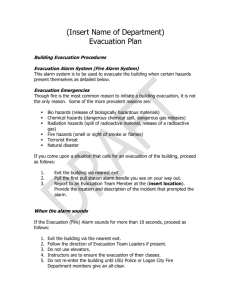High Rise Fire Safety
advertisement
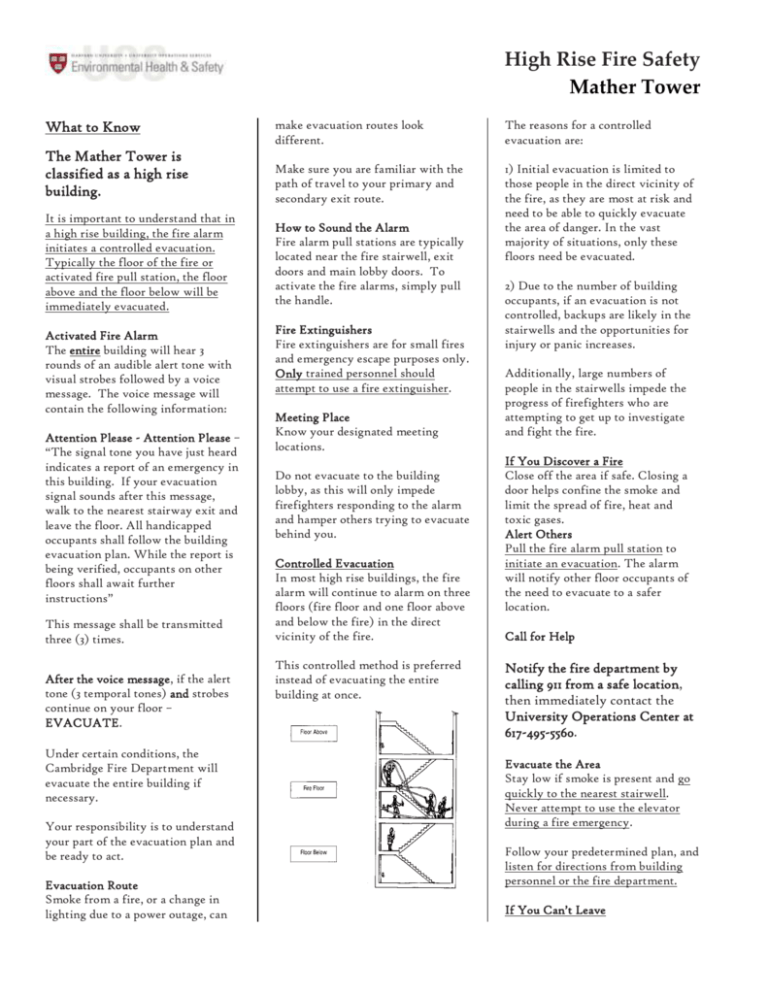
High Rise Fire Safety Mather Tower make evacuation routes look different. The reasons for a controlled evacuation are: The Mather Tower is classified as a high rise building. Make sure you are familiar with the path of travel to your primary and secondary exit route. It is important to understand that in a high rise building, the fire alarm initiates a controlled evacuation. Typically the floor of the fire or activated fire pull station, the floor above and the floor below will be immediately evacuated. How to Sound the Alarm Fire alarm pull stations are typically located near the fire stairwell, exit doors and main lobby doors. To activate the fire alarms, simply pull the handle. 1) Initial evacuation is limited to those people in the direct vicinity of the fire, as they are most at risk and need to be able to quickly evacuate the area of danger. In the vast majority of situations, only these floors need be evacuated. What to Know Activated Fire Alarm The entire building will hear 3 rounds of an audible alert tone with visual strobes followed by a voice message. The voice message will contain the following information: Attention Please - Attention Please – “The signal tone you have just heard indicates a report of an emergency in this building. If your evacuation signal sounds after this message, walk to the nearest stairway exit and leave the floor. All handicapped occupants shall follow the building evacuation plan. While the report is being verified, occupants on other floors shall await further instructions” This message shall be transmitted three (3) times. After the voice message, if the alert tone (3 temporal tones) and strobes continue on your floor – EVACUATE. Under certain conditions, the Cambridge Fire Department will evacuate the entire building if necessary. Your responsibility is to understand your part of the evacuation plan and be ready to act. Evacuation Route Smoke from a fire, or a change in lighting due to a power outage, can Fire Extinguishers Fire extinguishers are for small fires and emergency escape purposes only. Only trained personnel should attempt to use a fire extinguisher. Meeting Place Know your designated meeting locations. Do not evacuate to the building lobby, as this will only impede firefighters responding to the alarm and hamper others trying to evacuate behind you. Controlled Evacuation In most high rise buildings, the fire alarm will continue to alarm on three floors (fire floor and one floor above and below the fire) in the direct vicinity of the fire. This controlled method is preferred instead of evacuating the entire building at once. 2) Due to the number of building occupants, if an evacuation is not controlled, backups are likely in the stairwells and the opportunities for injury or panic increases. Additionally, large numbers of people in the stairwells impede the progress of firefighters who are attempting to get up to investigate and fight the fire. If You Discover a Fire Close off the area if safe. Closing a door helps confine the smoke and limit the spread of fire, heat and toxic gases. Alert Others Pull the fire alarm pull station to initiate an evacuation. The alarm will notify other floor occupants of the need to evacuate to a safer location. Call for Help Notify the fire department by calling 911 from a safe location, then immediately contact the University Operations Center at 617-495-5560. Evacuate the Area Stay low if smoke is present and go quickly to the nearest stairwell. Never attempt to use the elevator during a fire emergency. Follow your predetermined plan, and listen for directions from building personnel or the fire department. If You Can’t Leave High Rise Fire Safety Mather Tower Stay in an Area of Refuge There are two main options for an area of refuge. 1) 2) The fire rated stairwell if it is safe (free of smoke). An enclosed room with a window and a telephone. Review your options before an emergency situation arises. If You Choose the Stairwell Wait near the exit stairwell until everyone has evacuated the floor and traffic in the stairwell has cleared. Enter the stairwell and wait on the landing. Let evacuating people know that you will be in the stairwell and they should let the fire department know. Call the fire department on your cell phone if you have one; tell the fire department your exact location. Wait for further instructions. Breaking windows will put you at great risk to smoke entering from the outside, and will hamper rescue efforts below. Fire and Life Safety Systems High rise buildings in Cambridge have many built-in safety features that increase your safety if a fire does happen. Fire Alarm System All high rises have a fire alarm system monitored by an approved central station monitoring company. The Fire Department is notified immediately when an alarm is activated. Elevators Elevators are recalled to the building lobby when an elevator’s smoke detector is activated. This prevents elevators from being used by building occupants. The Fire Department will send firefighters to assist you if an evacuation is necessary. Exit Stairwells All high rises have at least two firerated exit stairwells, entered into through self closing, fire-rated doors. If you choose a room on the floor as your area of refuge: Keep the door to the room closed. A closed door is a barrier to smoke. Sprinklers Massachusetts high rises are equipped with sprinklers systems that significantly increase the occupant safety. Use towels or clothing to block openings around doors or vents where smoke might enter. Place a signal in but do not keep windows open. The signal can be anything that will call attention to your location. Call 9-1-1 to report your location. Emergency Generator An on-site diesel generator runs the fire and life safety systems in the event of a power outage. Cambridge Police - Fire Medical 911 If smoke or fire enters the room, stay low to the floor to breathe the best air. Put a wet cloth over your mouth or nose. Harvard University Police Department HUPD 495-1212 It is advisable not to keep open or break windows. Often smoke from the outside of the building can enter through open windows. Harvard University Operations Center 495-5560 For more fire safety information http://www.uos.harvard.edu

